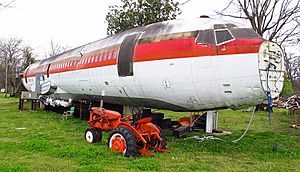Bolivar, Mississippi facts for kids
Quick facts for kids
Bolivar, Mississippi
|
|
|---|---|
| Country | United States |
| State | Mississippi |
| County | Bolivar |
| Area | |
| • Total | 0.25 sq mi (0.65 km2) |
| • Land | 0.25 sq mi (0.65 km2) |
| • Water | 0.00 sq mi (0.00 km2) |
| Elevation | 141 ft (43 m) |
| Population
(2020)
|
|
| • Total | 39 |
| • Density | 156.00/sq mi (60.32/km2) |
| Time zone | UTC-6 (Central (CST)) |
| • Summer (DST) | UTC-5 (CDT) |
| ZIP code |
38725
|
| GNIS feature ID | 667408 |
Bolivar is a small community in Bolivar County, Mississippi, United States. It is an unincorporated community, meaning it does not have its own local government. It is also a census-designated place, which is a special area defined for counting people during a census. In the 2020 Census, Bolivar had a population of 39 people.
Bolivar was once the main center of government for the county. Its port, called Bolivar Landing, was located on the Mississippi River. Today, Bolivar is a quiet residential area. Bolivar Landing is now a community of cottages on Lake Whittington, as it is no longer directly connected to the Mississippi River.
Contents
History of Bolivar
When Bolivar County was created in 1836, Bolivar was chosen as the first county seat. This meant it was the most important town where the county government was located. A man named William Vick sold about 5 acres of land to the county for $800. This land was then named Bolivar.
Early Buildings and Changes
A surveyor named B.M. Hines mapped out the town, including a square for the courthouse. Town lots around the square were sold. In 1840, the local government decided to build a simple one-room courthouse. It cost $595 to build.
However, in 1844, the county seat was moved. It first went to a spot north of present-day Beulah. Soon after, it moved again to Prentiss, where another courthouse was built.
Civil War Impact
During the American Civil War, Prentiss was almost completely destroyed. After this, the courthouse was put on a large flat-boat. It was floated down the river to Bolivar Landing.
A post office operated in Bolivar from 1830 to 1859.
In 1863, Trusten Polk, a former U.S. Senator and Governor of Missouri, was captured by Union soldiers at Bolivar Landing. His wife and two daughters were with him. In 1864, Union forces took supplies from Bolivar Landing. They also set fire to several houses. That same year, Confederate soldiers tried to burn the Union ship USS Collier near Bolivar Landing, but the ship was not destroyed.
River Changes and Lake Whittington
In 1874, the Mississippi River had very high waters. This caused a break in the levee at Bolivar Landing. The break was about 1,900 feet wide.
A big change happened in 1937. The U.S. Army Corps of Engineers completed something called the Caulk Island Cutoff. This project changed the path of the Mississippi River. It made the river flow in a more direct route for ships. Because of this, Bolivar Landing was cut off from the main Mississippi River. This created Lake Whittington, which is an oxbow lake. An oxbow lake forms when a bend in a river is cut off from the main flow.
Population Information
Bolivar is a small community. The 2020 Census counted 39 people living there.
| Historical population | |||
|---|---|---|---|
| Census | Pop. | %± | |
| 2020 | 39 | — | |
| U.S. Decennial Census 2020 |
|||
Bolivar in Popular Culture
The famous American writer Mark Twain mentioned Bolivar Landing in one of his humorous stories. It was called "River Intelligence" and was published in a newspaper in 1859. In the story, a fictional river captain named Sergeant Fathom jokes about how narrow the Mississippi River used to be. He says, "When me and DeSoto discovered the Mississippi, I could stand at Bolivar Landing... and pitch a biscuit to the main shore on the other side." This shows that Bolivar Landing was a recognizable place even back then.




